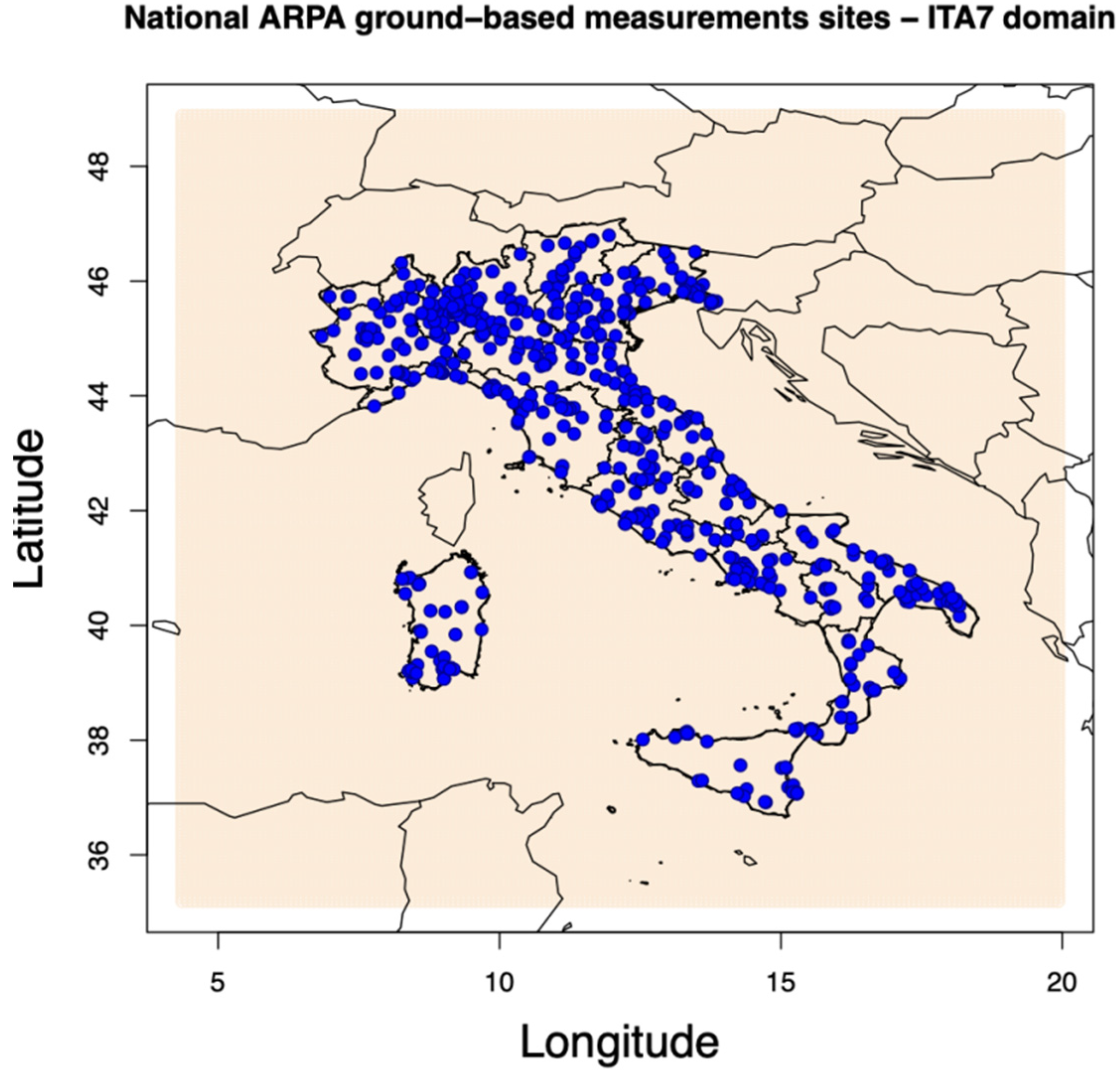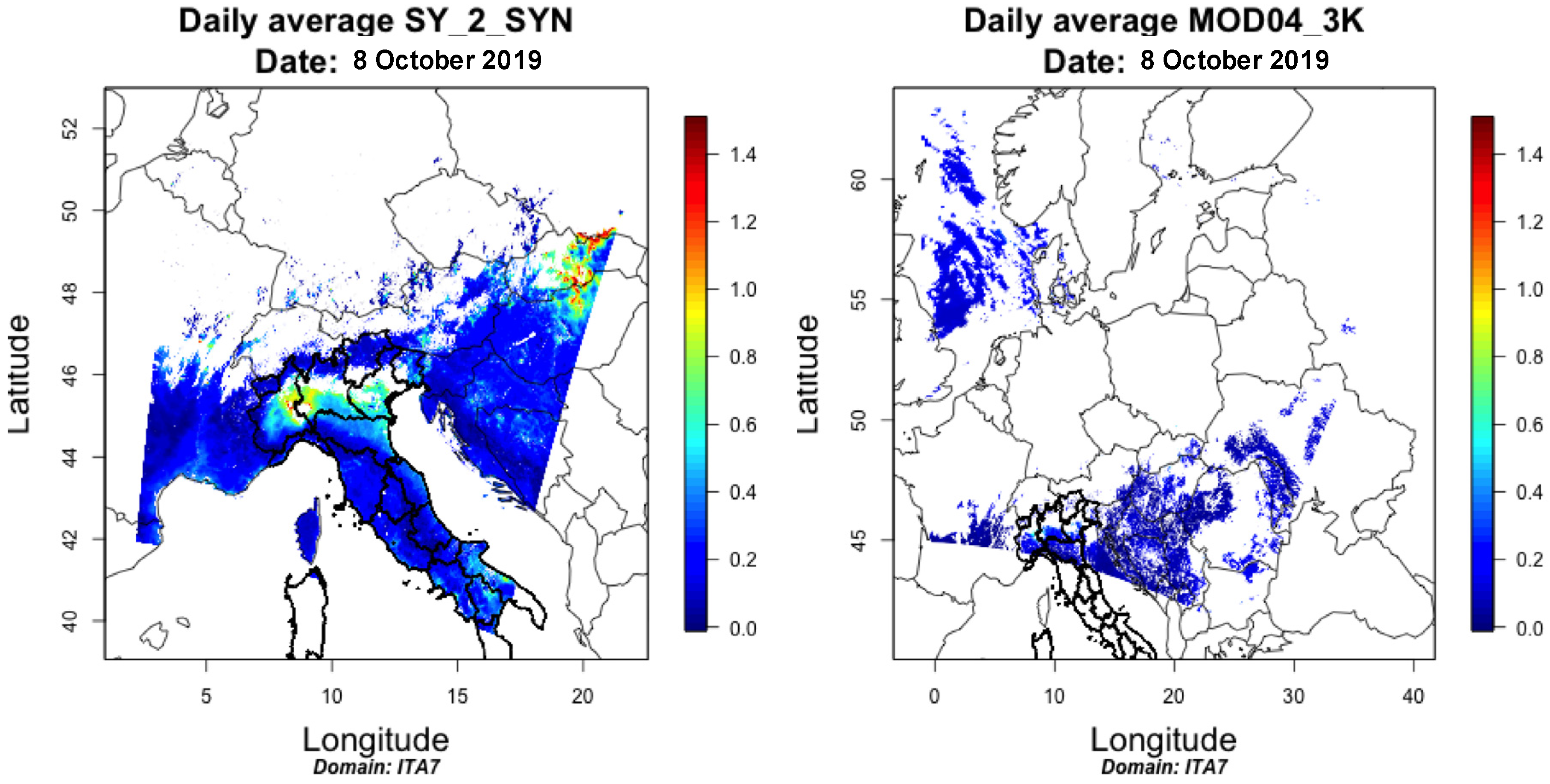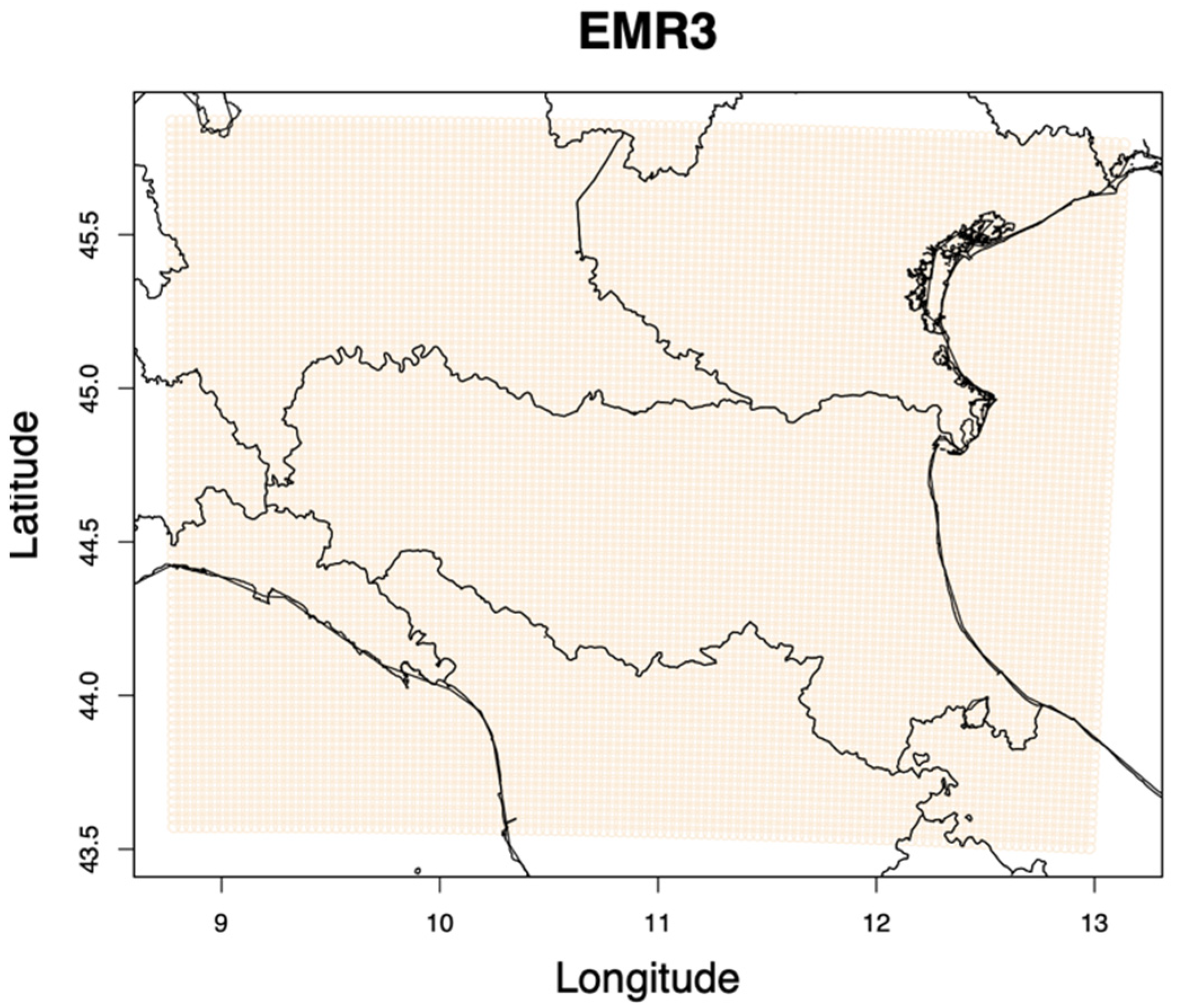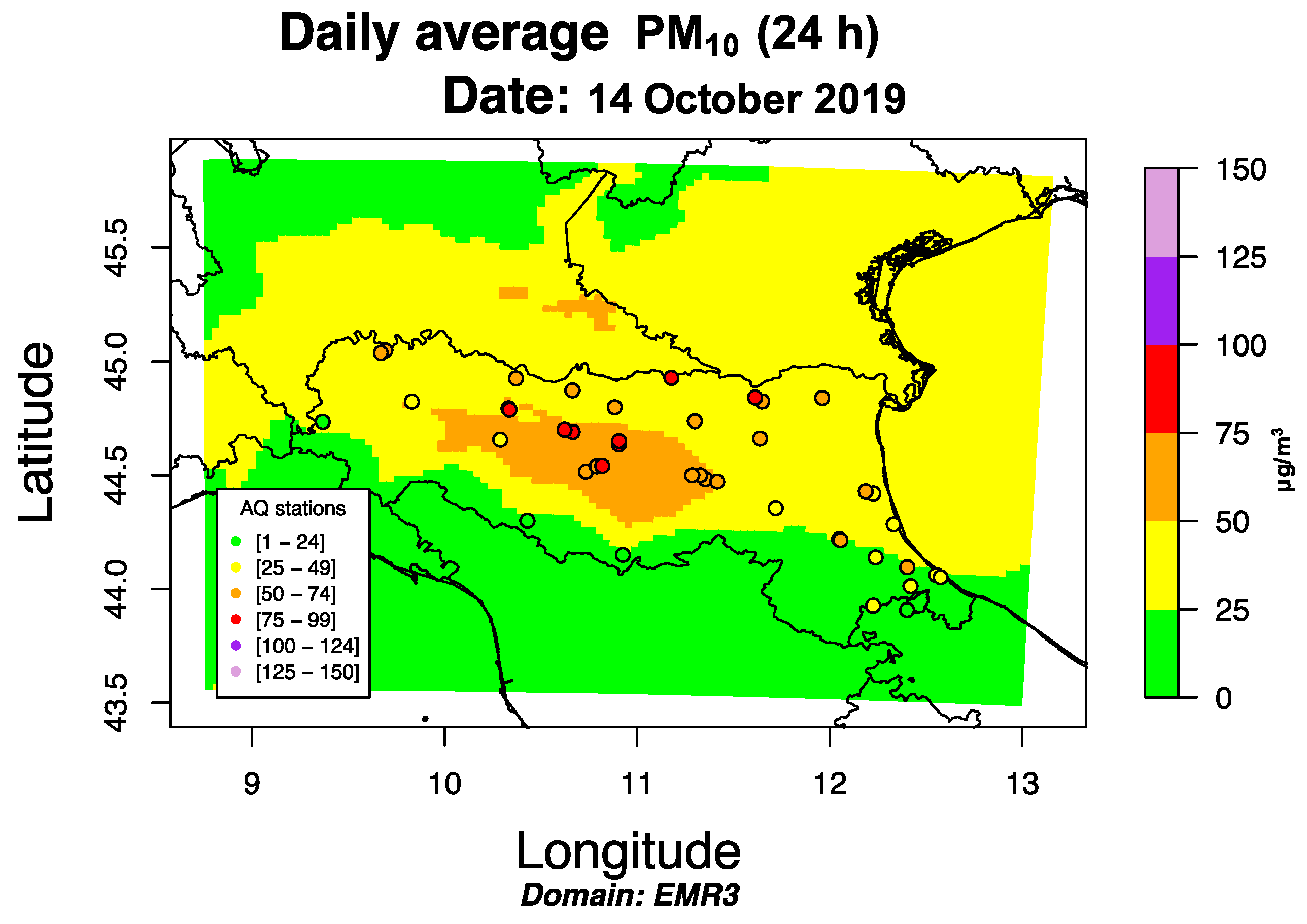Operational Forecast and Daily Assessment of the Air Quality in Italy: A Copernicus-CAMS Downstream Service
Abstract
1. Introduction
2. Air Quality Forecasting System
2.1. General Description
2.2. Numerical Air Model: CHIMERE Model Description
2.3. Input Data Setup
2.3.1. Domain Characterization and Geometric Configuration
2.3.2. Meteorological Data
2.3.3. Emissions Data
2.3.4. Surface Land Use
2.3.5. Gas Phase Chemistry
2.3.6. Aerosol Chemistry
2.4. Ground-Based Measurements
2.5. The Visualizer on Web
2.6. Air Quality Model System Validation Approach
Methodology
3. Remotely Sensed Data from Satellite Sentinel-3
4. System Application and Downscaling
4.1. An Example of a Regional Model Domain System: The EMR3
Example of Model Evaluation Tool on Regional Domain (EMR3)
4.2. Example of Model Evaluation Tool on the Italian Domain (ITA7)
5. Conclusions
- The presented system is run daily. Results are used by the Regional Italian Environmental Agencies to forecast peak pollution episodes and manage short-term emergency plans and to support long-term air quality improvement plans.
- The new system delivers everyday hourly boundary conditions to high-resolution air quality models at the regional scale. The model outputs and air quality data from ground monitoring stations which can be easily downloaded and visualized by a web service. They are available for free.
- Every day, in addition to the gas and PM concentration, the new service provides the meteorological input data for the chemical transport models.
- An algorithm for estimating the daily mean particulate matter concentration using satellite AOD retrieval data was implemented in the system.
- A verification tool called METOPA, which works on a routine basis, was included in the system. The tool is used to assess the confidence level of the model outputs and give information for the improvement of the modelling system.
- Future works will extend the verification analysis to cover at least a complete year. it will be possible to extend the model evaluation approach to the entire National domain with more robust, consistent, and reliable results.
Author Contributions
Funding
Acknowledgments
Conflicts of Interest
Appendix A. Model Statistics
- The Root Mean Square Error (RMSE), combines the spread of individual errors and is strongly dominated by the largest values due to the squaring operation,
- The BIAS represents the deviation between two datasets;The ideal value of this parameter is zero, while negative and positive values indicate respectively underestimation and overestimation.
- The Correlation coefficient (r),where and represent the average values of the time series for both observations and model simulations, respectively. The correlation coefficient indicates how efficient is the model to catch up the temporal fluctuations with respect to the observations.
- The Mean Absolute Error (MAE),is the measure of errors between paired observations and model simulations expressing the same phenomenon.
- The False Alarm Ration (FAR) represents the number of false alarms over the total number of warnings or alarms
- Probability of Detection (POD) represents the number of detections over the total number of observations.
References
- Guerreiro, C.; de Leeuw, F.; Viana, M.; Colette, A. Air Quality in Europe: 2018 Report; European Environment Agency: København, Denmark, 2018; ISBN 978-92-9213-990-2. [Google Scholar]
- Jacobson, M.Z. Air Pollution and Global Warming: History, Science, and Solutions; Cambridge University Press: Cambridge, UK, 2012. [Google Scholar]
- Pope, C.A., III; Burnett, R.T.; Thurston, G.D.; Thun, M.J.; Calle, E.E.; Krewski, D.; Godleski, J.J. Cardiovascular mortality and long-term exposure to particulate air pollution: Epidemiological evidence of general pathophysiological pathways of disease. Circulation 2004, 109, 71–77. [Google Scholar] [CrossRef] [PubMed]
- Honoré, C.; Rouil, L.; Vautard, R.; Beekmann, M.; Bessagnet, B.; Dufour, A.; Menut, L. Predictability of European air quality: Assessment of 3 years of operational forecasts and analyses by the PREV’AIR system. J. Geophys. Res. Atmos. 2008, 113, D04301. [Google Scholar] [CrossRef]
- Copernicus Official Web Site. Available online: https://www.copernicus.eu/en/services/atmosphere (accessed on 27 February 2020).
- Arvani, B.P. Seasonal monitoring and estimation of regional aerosol distribution over Po valley, northern Italy, using a high-resolution MAIAC product. Atmos. Environ. 2016, 141, 106–121. [Google Scholar] [CrossRef]
- Gupta, P.C. Satellite remote sensing of particulate matter and air quality assessment over global cities. Atmos. Environ. 2006, 40, 5880–5892. [Google Scholar] [CrossRef]
- Mailler, S.; Menut, L.; Khvorostyanov, D.; Valari, M.; Couvidat, F.; Siour, G.; Colette, A. CHIMERE-2017: From Urban to Hemispheric Chemistry-Transport Modeling. Geosci. Model Dev. 2017, 10, 2397–2423. [Google Scholar] [CrossRef]
- CHIMERE Documentation. Documentation of the Chemistry-Transport Model CHIMERE. 2017. Available online: https://www.lmd.polytechnique.fr/chimere/ (accessed on 27 February 2020).
- CHIMERE A Multi-Scale Chemistry-Transport Model for Atmospheric Composition Analysis and Forecast. Available online: https://www.lmd.polytechnique.fr/chimere/ (accessed on 27 February 2020).
- COSMO. Source Consortium for Small-scale Modeling. 2020. Available online: http://www.cosmo-model.org (accessed on 27 February 2020).
- Doms, G.; Baldauf, M. A Description of the Non hydrostatic Regional COSMO-Model. Part I: Dynamics and Numerics. 2015. Available online: User guide documentation at www.cosmo-model.org (accessed on 27 February 2020).
- Guenther, A.K. Estimates of global terrestrial isoprene emissions using MEGAN (Model of Emissions of Gases and Aerosols from Nature). Atmos. Chem. Phys. 2006, 6, 3181–3210. [Google Scholar] [CrossRef]
- Monahan, E.C. The Ocean as a Source of Atmospheric Particles. In The Role of Air-Sea Exchange in Geochemical Cycling; Kluwer Academic Publishers: Dordrecht, Holland, 1986; pp. 129–163. [Google Scholar]
- MACC-III Monitoring Atmospheric Composition and Climate 3. Available online: https://cordis.europa.eu/project/id/633080 (accessed on 27 February 2020).
- Kok, J.F.; Mahowald, N.M.; Fratini, G.; Gillies, J.A.; Ishizuka, M.; Leys, J.F.; Zobeck, T.M. An improved dust emission model-Part 1: Model description and comparison against measurements. Atmos. Chem. Phys. 2014, 14, 13023–13041. [Google Scholar] [CrossRef]
- Bessagnet, B.; Hodzic, A.; Vautard, R.; Beekmann, M.; Cheinet, S.; Honoré, C.; Liousse, C.; Rouil, L. Aerosol modeling with CHIMERE: Preliminary evaluation at the continental scale. Atmos. Environ. 2004, 38, 2803–2817. [Google Scholar] [CrossRef]
- Riccio, A.; Barone, G.; Chianese, E.; Giunta, G. A hierarchical Bayesian approach to the spatio-temporal modeling of air quality data. Atmos. Environ. 2006, 40, 554–566. [Google Scholar] [CrossRef]
- Wilks, D.S. Statistical Methods in the Atmospheric Sciences; Academic Press: Cambridge, MA, USA, 2011. [Google Scholar]
- Gupta, P.; Christopher, S.A. Seven Year Particulate Matter Air Quality Assessment from Surface and Satellite Measurements. Atmos. Chem. Phys. Discuss. 2008, 8, 327–365. [Google Scholar] [CrossRef]
- Emili, E.; Lyapustin, A.; Wang, Y.; Popp, C.; Korkin, S.; Zebisch, M.; Wunderle, S.; Petitta, M. High spatial resolution aerosol retrieval with MAIAC: Application to mountain regions. J. Geophys. Res. Atmos. 2011, 116, D23211. [Google Scholar] [CrossRef]
- Donlon, C.; Berruti, B.; Buongiorno, A.; Ferreira, M.H.; Féménias, P.; Frerick, J.; Nieke, J. The global monitoring for environment and security (GMES) sentinel-3 mission. Remote Sens. Environ. 2012, 120, 37–57. [Google Scholar] [CrossRef]
- Ping, B.; Su, F.; Meng, Y. An improved DINEOF algorithm for filling missing values in spatio-temporal sea surface temperature data. PLoS ONE 2016, 11, e0155928. [Google Scholar] [CrossRef] [PubMed]
- Bigi, A.; Ghermandi, G. Long-term trend and variability of atmospheric PM10 concentration in the Po Valley. Atmos. Chem. Phys. 2014, 14, 4895–4907. [Google Scholar] [CrossRef]
- INEMAR Official Site. Available online: http://www.inemar.eu (accessed on 27 February 2020).










| Period: October 2019 | ||||||
|---|---|---|---|---|---|---|
| PM10 | NO2 | O3 | ||||
| EMR3 | CAMS | EMR3 | CAMS | EMR3 | CAMS | |
| Bias (μg/m3) | −4.85 | −8.17 | 4.3 | −6.15 | 16.91 | 10.95 |
| RMSE (μg/m3) | 11.42 | 12.96 | 16.48 | 11.95 | 28.01 | 19.33 |
| r | 0.72 | 0.76 | 0.51 | 0.56 | 0.63 | 0.78 |
| MAE (μg/m3) | 8.72 | 9.35 | 10.98 | 7.61 | 22.4 | 15.4 |
| FAR | 0.44 | 0.43 | 0 | 0 | 0 | 0 |
| POD | 0.22 | 0.06 | 0 | 0 | 0 | 0 |
| Period: October 2019 | ||||||
|---|---|---|---|---|---|---|
| PM10 | NO2 | O3 | ||||
| ITA7 | CAMS | ITA7 | CAMS | ITA7 | CAMS | |
| Bias (μg/m3) | −5.58 | −6.24 | −17.42 | −25.97 | 17.60 | 3.43 |
| RMSE (μg/m3) | 11.90 | 10.71 | 26.97 | 32.81 | 34.55 | 26.30 |
| r | 0.55 | 0.69 | 0.40 | 0.49 | 0.33 | 0.48 |
| MAE (μg/m3) | 8.86 | 7.71 | 20.17 | 26.06 | 24.02 | 13.69 |
| FAR | 0.45 | 0.31 | 0 | 0 | 0 | 0 |
| POD | 0.12 | 0.12 | 0 | 0 | 0 | 0 |
© 2020 by the authors. Licensee MDPI, Basel, Switzerland. This article is an open access article distributed under the terms and conditions of the Creative Commons Attribution (CC BY) license (http://creativecommons.org/licenses/by/4.0/).
Share and Cite
Stortini, M.; Arvani, B.; Deserti, M. Operational Forecast and Daily Assessment of the Air Quality in Italy: A Copernicus-CAMS Downstream Service. Atmosphere 2020, 11, 447. https://doi.org/10.3390/atmos11050447
Stortini M, Arvani B, Deserti M. Operational Forecast and Daily Assessment of the Air Quality in Italy: A Copernicus-CAMS Downstream Service. Atmosphere. 2020; 11(5):447. https://doi.org/10.3390/atmos11050447
Chicago/Turabian StyleStortini, Michele, Barbara Arvani, and Marco Deserti. 2020. "Operational Forecast and Daily Assessment of the Air Quality in Italy: A Copernicus-CAMS Downstream Service" Atmosphere 11, no. 5: 447. https://doi.org/10.3390/atmos11050447
APA StyleStortini, M., Arvani, B., & Deserti, M. (2020). Operational Forecast and Daily Assessment of the Air Quality in Italy: A Copernicus-CAMS Downstream Service. Atmosphere, 11(5), 447. https://doi.org/10.3390/atmos11050447





